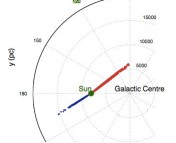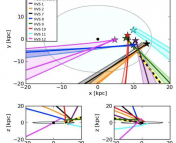TITLE: The SLUGGS Survey: Calcium Triplet-based Spectroscopic Metallicities for Over 900 Globular Clusters
AUTHORS: Christopher Usher et al.
FIRST AUTHOR’S INSTITUTION: Center for Astrophysics and Supercomputer, Swinburne University of Technology
In this paper, the SLUGGS team explores an alternate way to determine the metallicity of a globular cluster. Metallicity is the ratio between hydrogen, which was created in the Big Bang, and metals, i.e. anything heavier than lithium. Since metals must be made in stars, a higher metal content indicates a later formation time. Previous studies have shown what appear to be two peaks in the metallicity of the population of globular clusters surrounding early-type galaxies – a bimodal distribution – but some astronomers have pointed out that the way we measure metallicity in globular clusters can make a unimodal distribution in metallicity appear as a bimodal one. Galactic astronomers are interested in figuring out whether the real distribution is unimodal or bimodal, since a bimodal distribution would imply two major star formation episodes in the history of a galaxy, each producing its own group of globular clusters, rather than just one.
Metallicity is difficult to measure directly even when it’s possible to obtain a spectrum for an object. When astronomers need to measure the metallicity of faint or faraway objects, or when they need to measure the metallicity of hundreds of objects at once, they rely on calibrated relationships that relate metallicity to other, more easily-observed properties, called proxies. These equations are derived by measuring both the variable of interest and the proxy variable in a number of cases and fitting a relationship between the two. If the objects of interest have the same fundamental properties as the objects used to calibrate the equation, those objects should also have the same relationship between the proxy and the variable of interest.

Globular cluster data measured for NGC 4278. The horizontal axis gives metallicity as derived by the color-metallicity relation, while the vertical axis gives metallicity as measured by the calcium triplet. The histograms on the top and right give the metallicity distributions, both showing bimodal fits. (Image credit: Usher et al. 2012)
In the case of globular clusters, astronomers use a color-metallicity relationship. They measure the color of a cluster, which is more easily obtained via photometry, and from this formula they can derive a metallicity. However, because many color-metallicity relationships have flat intermediate regions – areas where a small change in underlying metallicity equates to a large change in color – it has been shown that a unimodal metallicity distribution can appear bimodal. The SLUGGS team uses a different proxy: the calcium triplet.
The calcium triplet consists of three atomic lines at 8498 A, 8542 A, and 8662 A. It’s one of the strongest stellar spectral features in the optical/NIR, and its strength increases with metallicity. They first calibrate a relationship between the strength of the calcium triplet and the metallicity of a cluster, then use this relationship to explore whether the observed bimodal distribution in metallicity of globular clusters is real or an artifact of the color-metallicity formula.
The SLUGGS team assembled the largest spectroscopic globular cluster metallicity dataset yet analyzed, composed of 903 globular clusters around 11 early-type galaxies. Eight of these galaxies had data of sufficiently high quality to be useful, and in six of these galaxies the team finds metallicity bimodality. This agrees with the color-metallicity results, and implies that most massive galaxies have undergone multiple epochs of star formation. However, there are still some issues with the relation – in half of the galaxies sampled, the distribution of calcium triplet-based metallicities did not agree with the color-metallicity distribution at either the low or high end of the metallicity range. A larger sample of extragalactic globular clusters will be required before the question can be answered with certainty.




